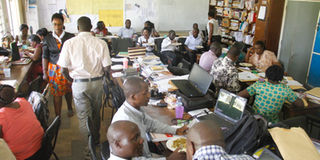Old Girls fundraise for Gayaza staffroom

Above: The Gayaza High School staff room serves as a resource centre as well as dining hall making it hard for teachers to concentrate. Bottom left: An artistic impression of the new staff room. Photo by Abubaker Lubowa
What you need to know:
Old Girls of Gayaza High School have organised a fundraising dinner for October 10, to helpconstruct a modern staffroom. With more than 30 teachers, the current staffroom can barely accomodate the numbers since it was intended for fewer teachers
Teachers are what make a school. If they are facilitated with a good working environment, then parents have a right to expect better results from them.
But lunch time in the staff room of Gayaza High School is a crowded affair.
The tables overflow with untidy heaps of books and papers. Bags and laptops also jostle for space. Squeezed into any available space or on top of the books are plates of food – rice, matooke and peas.
Those who cannot find seats in the room carry chairs to the well-manicured lawn just opposite the serving point.
High up to the left corner, a 21-inch screen is blaring out an interview of a local musician, probably the lunchtime request hour.
The din from more than 30 teachers, catching up with conversation as they eat, almost drowns out the TV sound.
At the staffroom door, students signal to those inside, hoping to catch the attention of a teacher.
This is the situation that got the Gayaza Old Girls’ Association (Goga) thinking of ways to give back to the school that nurtured them.
“This staffroom was built in the 1960s to accommodate 20 staff members, but now they are 75,” says Elizabeth Katigo, a former student.
“Imagine a situation where a teacher arrives to work at 7am but cannot find a seat. If they find seats, at some point they have to go to the classrooms to teach. When they come back, that seat has been taken over by someone else.”
Staff room woes
Maria Goretti Nampajji, who has taught at the school since 2007, agrees, saying the staffroom has outlived its time.
“We have nowhere to keep our books. Even the restroom is not enough for us, which means some teachers cannot attend sports events because there is no privacy to dress.”
The challenge of a crowded setting is that not everyone can concentrate.
“I might want to mark books while someone wants to watch news on TV, which makes it hard to concentrate,” says Michael Kayongo, who has taught in the school for 11 years.
With a congested room, there is often no space to place marked books. When there is a staff meeting, teachers have to sit in the library. This can also be an inconvenience to students who plan to use the library at that time.”
Comparing then and now
Monica Kalange Eriatu studied at Gayaza from 1973 to 1976. Last year, she came back as a teacher.
“In the 70s, the staffroom was not as easily accessible to students as it is nowadays. There were few teachers then, half of them British. Facilities, like the pigeon holes, were enough, then.”
Another surprising aspect is that there is a sizable number of male teachers, something that was unheard of 20 years ago.
“In my time, there were about five male teachers, handling the sciences and art and craft department,” says Eriatu. “The girls were excited just by talking to those teachers.”
Ronald Ddungu, the deputy head teacher, attributes the big number of male teachers to the government policy on science subjects.
“At universities, most of those who qualify as science teachers are male. With the emphasis on sciences, we find ourselves hiring a large number of male teachers.”
Sarah Maganya, an Old Girl of the school who has been teaching for 20 years, says that although in the mid-1990s the space was enough, they lacked lockers where to place their plates.
“Everyone came with a plate and cup and we would store them in the lockers with our books. One day, a PTA member, Ms Kadama, had lunch with us and she noticed the different colours of the plates. She offered us uniform plates but they lasted only a year.”
To reduce the congestion, departmental rooms were built.
“For instance, there are rooms for the French, German, and counselling departments where teachers spend their time and only come to the staffroom at lunch time,” says Maganya.
The planned staffroom
The staffroom building project is expected to utilise the space on which the current staffroom stands. It is estimated to accommodate at least 120 staff members.
“There will also be a nursery for toddlers so that nursing mothers do not suffer the stress of rushing home to breastfeed,” says Katigo.
The building will have study rooms for teachers who seek quiet places to reflect on their work.
And most importantly, each teacher will have a pigeonhole where students can post their work, instead of standing at the doorway, waiting to catch a teacher’s attention.
“The projections and designs were made, and we came up with a sum of Shs 1bn,” says Katigo.
“As soon as we have collected enough, we will start building. This school has been around for more than 100 years. If we can collect Shs1m from every former student, we can complete this project.”
The new staffroom will be unveiled by the next Gayaza Day in June 2016. Goga has organised a fundraising dinner for October 10, at the Serena Hotel Gardens. The dinner will cost Shs 200,000 per head and Shs 3m for a table of 10.




